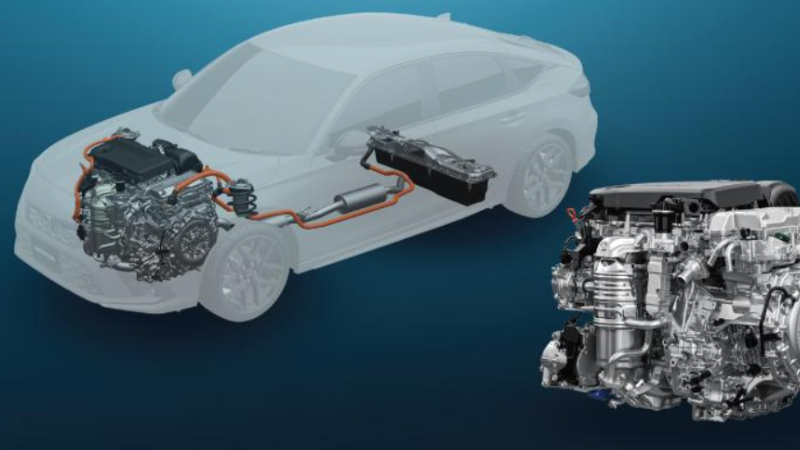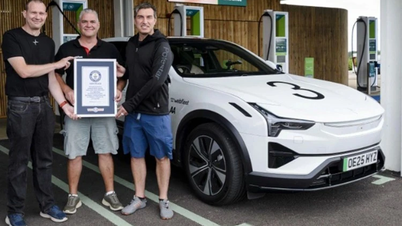
According to Dr. Nguyen Hung Manh, Lecturer of the Faculty of Mechanical - Automobile and Construction (Electricity University), hybrid vehicles, also known as gasoline-electric hybrid vehicles, use both an internal combustion engine and an electric motor. Internal combustion engines, which often use gasoline or diesel, are familiar to consumers; while electric motors use electric energy to help the vehicle accelerate smoothly and significantly reduce emissions. This combination allows hybrid vehicles to take advantage of the strengths of both types of engines, maintaining stable operation at high speeds while saving fuel and being more environmentally friendly. The intelligent control system on the vehicle will automatically select and coordinate the two power sources depending on operating conditions. When starting or moving slowly in the city, the vehicle often runs on electricity to reduce fuel consumption and limit noise.
Most hybrids have four operating modes. In electric mode, the electric motor provides all the traction to the wheels. Hybrid mode is the main mode, combining both the gasoline engine and the electric motor to increase traction when needed, such as when accelerating or climbing a hill. Pure gasoline mode is used when the car is running at high and stable speeds, such as on the highway, because that is when the gasoline engine works most efficiently, and the electric motor is hardly involved. Finally, there is regenerative braking mode, when the car is slowing down or going downhill, the electric motor switches to the role of a generator, recovering energy from the car's movement and feeding it back to the high-voltage battery.
The heart of the hybrid system is the battery, with a self-charging mechanism during operation, without needing to be plugged into an external power source like a pure electric vehicle. The battery is charged from two main sources: energy recovery when braking (regenerative braking) and charging from the gasoline engine when needed, which helps the vehicle always have enough electricity to support the internal combustion engine, while reducing fuel consumption.
Another advantage of hybrid cars is that they do not depend entirely on charging infrastructure. In Vietnam, where charging infrastructure for electric cars is limited, hybrid cars are considered a solution. The market has begun to see the participation of many car manufacturers with hybrid models in many segments, and consumers are interested in this type of car not only because of fuel economy but also because of the "green" image associated with the trend of sustainable living.
A representative of Honda Vietnam Company said: “Current Honda hybrid car models have a basic urban cycle fuel consumption of about 4.5 liters/100 km. Fuel economy and emission reduction depend on a number of factors such as driving conditions, load, idling time, driving habits and vehicle condition. Hybrid engines are about 30% more fuel efficient than vehicles using pure gasoline engines, thereby significantly reducing the amount of toxic gases emitted into the environment.”
According to Dr. Nguyen Hung Manh, each type of vehicle has its own technical characteristics and needs to be evaluated based on specific criteria. In terms of greenhouse gas emissions during operation, hybrid vehicles operate mainly on the basis of internal combustion engines, so they still emit greenhouse gases and toxic gases into the environment, while pure electric vehicles operate completely without emissions (not considering emissions at the place where the power source is generated). However, compared to vehicles running entirely on gasoline or diesel, hybrid vehicles have significantly reduced emissions. The reason is that although the internal combustion engine still plays a major role and operates regularly, it is always operated within the optimal speed range, helping to save fuel and reduce emissions.
In terms of investment and maintenance costs, the hybrid vehicle powertrain has a complex structure, integrating both an internal combustion engine and an electric motor, leading to specific technical requirements in production and maintenance. Maintenance and repair must be carried out in accordance with technical procedures to ensure safety and efficiency. Therefore, consumers need to carefully consider the conditions of use, access to technical services and appropriate maintenance costs.
In terms of operating range and energy access, the disadvantage of pure electric vehicles is limited travel distance due to dependence on current battery development technology and long stable and safe charging time. Hybrid vehicles do not depend on charging station infrastructure like pure electric vehicles, thanks to still using popular gasoline and diesel fuel. In situations of long distance travel or lack of charging infrastructure, this is an advantage that helps maintain operational flexibility.
Regarding electrical safety and battery life, pure gasoline and diesel vehicles do not have a major risk of high voltage sources, while hybrid or pure electric vehicles always have potential risks of high voltage electrical safety and explosion, requiring strict compliance with safety standards. Battery life depends on operating conditions, ambient temperature and usage habits, periodic inspection and maintenance of the battery system is necessary to ensure long-term performance and safety.
Currently, car manufacturers are increasingly developing and launching many hybrid models, considering this a reasonable transition between traditional fuel vehicles and pure electric vehicles. This trend comes from the need to reduce emissions, save fuel and adapt to the asynchronous charging infrastructure in many countries.
With the energy transition trend and Vietnam's commitment to reduce net emissions, hybrid vehicles have many opportunities to develop, but still face many challenges, especially when consumers still confuse this type of vehicle with pure electric vehicles, or are concerned about battery life and replacement costs.
Source: https://nhandan.vn/cong-nghe-hybrid-thuc-day-phuong-tien-xanh-post903146.html
































































































Comment (0)